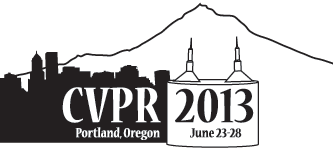-
Histograms of Sparse Codes for Object Detection
AbstractObject detection has seen huge progress in recent years, much thanks to the heavily-engineered Histograms of Oriented Gradients (HOG) features. Can we go beyond gradients and do better than HOG? We provide an affirmative answer by proposing and investigating a sparse representation for object detection, Histograms of Sparse Codes (HSC). We compute sparse codes with dictionaries learned from data using K-SVD, and aggregate per-pixel sparse codes to form local histograms. We intentionally keep true to the sliding window framework (with mixtures and parts) and only change the underlying features. To keep training (and testing) efficient, we apply dimension reduction by computing SVD on learned models, and adopt supervised training where latent positions of roots and parts are given externally e.g. from a HOG-based detector. By learning and using local representations that are much more expressive than gradients, we demonstrate large improvements over the state of the art on the PASCAL benchmark for both rootonly and part-based models.
Related Material
[pdf][bibtex]@InProceedings{Ren_2013_CVPR,
author = {Ren, Xiaofeng and Ramanan, Deva},
title = {Histograms of Sparse Codes for Object Detection},
booktitle = {Proceedings of the IEEE Conference on Computer Vision and Pattern Recognition (CVPR)},
month = {June},
year = {2013}
}
These CVPR 2013 papers are the Open Access versions, provided by the Computer Vision Foundation.
Except for the watermark, they are identical to the accepted versions; the final published version of the proceedings is available on IEEE Xplore.
Except for the watermark, they are identical to the accepted versions; the final published version of the proceedings is available on IEEE Xplore.
This material is presented to ensure timely dissemination of scholarly and technical work.
Copyright and all rights therein are retained by authors or by other copyright holders.
All persons copying this information are expected to adhere to the terms and constraints invoked by each author's copyright.

